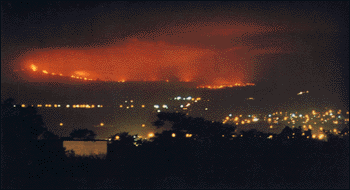1) What warms the planet?
Climate scientists have agreed that the main reason for global warming is because of the "greenhouse effect" , its where the atmosphere traps heat radiating from the earth to space. Some gases in the atmosphere also block heat from escaping. Greenhouse gases are a factor which keeps the planet warm.
Climate scientists have agreed that the main reason for global warming is because of the "greenhouse effect" , its where the atmosphere traps heat radiating from the earth to space. Some gases in the atmosphere also block heat from escaping. Greenhouse gases are a factor which keeps the planet warm.
2) Referring to this diagram explain why the equatorial regions receive more radiation and therefore are warmer than polar regions.
Referring to the diagram, it is seen that the equatorial regions receive more radiation causing it to be warmer than polar regions because the sun rays are stronger at the equator. The strong sun rays cause it to be consistently warm and to have characteristics of that of tropical weather.
 3) Define Albedo. Which would absorb more radiation a snow covered mountain or a black roof?
3) Define Albedo. Which would absorb more radiation a snow covered mountain or a black roof? Albedo is the amount or proportion of the incident light or radiation that is reflected by a surface like a planet or the moon.
A black roof would absorb more radiation because it gets heated much faster due to the black roof absorbing all wavelengths of light and reflecting none.
4) Explain lapse rate.
Lapse rate is the rate at which temperature drops while the altitude increases.
5) Explain Aspect. In the Northern Hemisphere will plants grow better on the north or the south side facing side of a mountain?
Aspect is the compass direction which a slope faces for example a slope on the eastern edge of the Rockies towards the Great Plains is known to have an easterly aspect.
Aspect is the compass direction which a slope faces for example a slope on the eastern edge of the Rockies towards the Great Plains is known to have an easterly aspect.
In the Northern Hemisphere, plants will grow better on the south facing side of a mountain since it receives more solar radiation and it is not directly shaded by the earth itself.
6) Why do we have seasons?
We have seasons because the earth is tilting on the axis as it makes its yearly rotation around the sun.
We have seasons because the earth is tilting on the axis as it makes its yearly rotation around the sun.
7) Which heats up faster: Land or Water?
Land heats up faster than water since land absorbs more heat at a faster pace than water does.
8) Describe the impact that being far away from water has on the climate of the prairies
Being far away from water causes prairie summers to be hot and humid, and winters to be cold because the region is far from the temperature moderating effect of the oceans. Hence the people on the prairies have to endure the extremities of each season without any moderation.
Being far away from water causes prairie summers to be hot and humid, and winters to be cold because the region is far from the temperature moderating effect of the oceans. Hence the people on the prairies have to endure the extremities of each season without any moderation.
9) Explain the impact of the Gulf Stream on Norway.
When the gulf stream is strong, it is known for bringing more warm water northwards which results in Norway getting warmer. That is why Norwegians can enjoy temperatures five to ten degrees warmer than other places so far north.
10) What current runs past BC?
The California Current is a pacific ocean current which starts from southern British Columbia to southern Baja California. It runs past BC through the pacific ocean.
11) Describe the impact of adding extra carbon dioxide to the atmosphere on the temperatures of Earth.
Adding extra carbon dioxide to the atmosphere will cause a greenhouse effect because of the interaction between the suns energy and one of the principle greenhouse gases, carbon dioxide. This will increase the temperature of the earth by trapping heat in our atmosphere hence it will get warmer.
12) Describe convection. THIS IS IMPORTANT TO UNDERSTAND AS WE MOVE THROUGH THE COURSE
Convection is basically the movement in a gas or liquid in which the warmer parts ( hotter tendency materials) move the less dense material up to rise and the colder parts (colder tendency) causes the dense materials to go down and sink because of gravity. It is also known as transfer of heat from this movement.
13) What is wind?
Wind is the natural movement of air which is usually in the form of a current of air blowing from a particular direction.
14) Explain urban heat islands, and explain why they occur.
Urban heat islands are a metropolitan area which is significantly warmer than its surrounding rural areas because of human activities.
This occurs due to many populated people and lots of infrastructure in metropolitan areas. Another reason why metropolitan areas are warmer is that they produce lots of greenhouses gases than rural areas.
Urban heat islands are a metropolitan area which is significantly warmer than its surrounding rural areas because of human activities.
This occurs due to many populated people and lots of infrastructure in metropolitan areas. Another reason why metropolitan areas are warmer is that they produce lots of greenhouses gases than rural areas.








